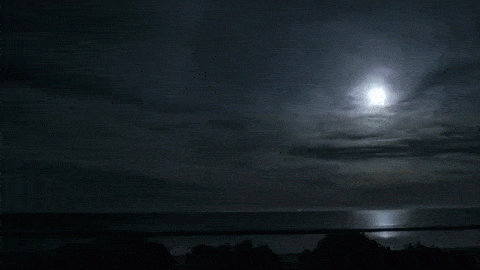Friday, January 14th 2022, 3:35 pm - This is the farthest, smallest, and dimmest Full Moon of 2022. Whatever you are up to on Monday night, if you have reasonably clear skies, spare a few moments to take in the splendour of the Moon. Rising just before sunset, the Full Wolf Moon will be up all night long and will slip below the western horizon just after the Sun rises. So, there is plenty of time to check it out.
Most of us know about supermoons, when the Full Moon is closer and brighter than usual. However, have you heard about the 'micromoon'?
Opposite of a supermoon, a micromoon is a Full Moon that occurs near its farthest point from Earth in its orbit. That makes it appear smaller and dimmer than a typical Full Moon.
Monday night's Wolf Moon is the first of only two micromoons for this year, and we have to wait until December to see the second. It is also the year's apogee micromoon — the farthest, smallest, and dimmest Full Moon for all of 2022.
The full January moon carries a cool nickname, the “wolf moon” — a monicker that was coined by Native American tribes that would often hear packs of hungry wolves howling on cold and snowy nights in the middle of winter.
“It was traditionally thought that they howled due to hunger, but there is no evidence for this," the publication says. “However, wolves do tend to howl more often during winter months, and generally howl to define territory, locate pack members, and gather for hunting.”
Full moon names date back to Native Americans of a few hundred years ago, of what is now the northern and eastern United States. To keep track of the changing seasons, these tribes gave distinctive names to each recurring full moon. Their names were applied to the entire month in which each occurred.
There were some variations in the moon names, but in general, the same ones were used throughout the Algonquin tribes from New England, continuing west to Lake Superior.
European settlers followed their own customs and created some of their own names.
The Full Wolf Moon. Amid the cold and deep snows of midwinter, the wolf packs howled hungrily outside Native American villages. This moon was also known as the Old Moon or the Moon after Yule. In some tribes it was called the Full Snow Moon, but most applied that name to the next moon.
January Moon Names: Man Moon (Taos). Joyful Moon (Hopi). Avunniviayuk (Inuit). Quite Moon (Celtic). Ice Moon (San Juan). Cold Moon (Cherokee). Ice Moon (Neo-Pagan). Flying Ant Moon(Apache). Big Cold Moon (Mohawk). Cooking Moon (Choctaw). Strong Cold Moon (Sioux). Little Winter Moon (Creek). Her Cold Moon (Wishram). Cold Meal Moon (Natchez). Moon After Yule (Cherokee). Wolf Moon (Medieval English). Strong Cold Moon (Cheyenne). Quiet : Dark, Wolf : Full (Janic). Great Spirit Moon (Anishnaabe). Whirling Wind Moon (Passamaquoddy). Wolf Moon, Old Moon, Winter Moon, Yule Moon (Algonquin).
VIDEO Wolves serenade the moon
Most of us know about supermoons, when the Full Moon is closer and brighter than usual. However, have you heard about the 'micromoon'?
Opposite of a supermoon, a micromoon is a Full Moon that occurs near its farthest point from Earth in its orbit. That makes it appear smaller and dimmer than a typical Full Moon.
Monday night's Wolf Moon is the first of only two micromoons for this year, and we have to wait until December to see the second. It is also the year's apogee micromoon — the farthest, smallest, and dimmest Full Moon for all of 2022.
The full January moon carries a cool nickname, the “wolf moon” — a monicker that was coined by Native American tribes that would often hear packs of hungry wolves howling on cold and snowy nights in the middle of winter.
“It was traditionally thought that they howled due to hunger, but there is no evidence for this," the publication says. “However, wolves do tend to howl more often during winter months, and generally howl to define territory, locate pack members, and gather for hunting.”
Full moon names date back to Native Americans of a few hundred years ago, of what is now the northern and eastern United States. To keep track of the changing seasons, these tribes gave distinctive names to each recurring full moon. Their names were applied to the entire month in which each occurred.
There were some variations in the moon names, but in general, the same ones were used throughout the Algonquin tribes from New England, continuing west to Lake Superior.
European settlers followed their own customs and created some of their own names.
The Full Wolf Moon. Amid the cold and deep snows of midwinter, the wolf packs howled hungrily outside Native American villages. This moon was also known as the Old Moon or the Moon after Yule. In some tribes it was called the Full Snow Moon, but most applied that name to the next moon.
January Moon Names: Man Moon (Taos). Joyful Moon (Hopi). Avunniviayuk (Inuit). Quite Moon (Celtic). Ice Moon (San Juan). Cold Moon (Cherokee). Ice Moon (Neo-Pagan). Flying Ant Moon(Apache). Big Cold Moon (Mohawk). Cooking Moon (Choctaw). Strong Cold Moon (Sioux). Little Winter Moon (Creek). Her Cold Moon (Wishram). Cold Meal Moon (Natchez). Moon After Yule (Cherokee). Wolf Moon (Medieval English). Strong Cold Moon (Cheyenne). Quiet : Dark, Wolf : Full (Janic). Great Spirit Moon (Anishnaabe). Whirling Wind Moon (Passamaquoddy). Wolf Moon, Old Moon, Winter Moon, Yule Moon (Algonquin).
VIDEO Wolves serenade the moon




Responses to "Happy Full Wolf Moon 2022: What You Need to Know About January's Full Moon"